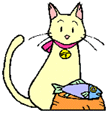Vol. 2, No. 33
Table of Contents
Feline Nutrition: Conflicting Thoughts
Assist Feeding: Tube Feeding Skip: PHOTOS
Kitty Potpourri: Beat the Heat!
Best Cat Food: Ocean Breeze
Caring for Cats: Managing Guilt – Part 3
Feline Nutrition
Conflicting Thoughts
by Garry White
FOREWORD (This really belongs in Caring For Cats, but we’ve got that spot dedicated for a few weeks, so I’m posting it here.
True Story: well, true as it was told to me, and I have no reason to question the teller. A lady here in Connecticut manages a bunch of feral cats, helps get them spayed and neutered, and such. She has a cat that has been around her barn for years and years. Several weeks ago, she went to set food down and the cat scratched her hand. The hand became infected, she’s had three surgeries, and as of a few days ago she was told the hand will have to be amputated. The Doc’s haven’t a clue what the infection is, but they cannot control it. So obviously my caution is to please be careful when dealing with all feral animals as there’s no way to tell what they may have clawed at recently.
Conflicting Thoughts:
How many of us jump the gun when we see odd behavior, or what we might call an anomaly? Kitty does something we consider “not normal,” and it means we have a problem on our hands, right? Well, I’ve noted something with Clarkie boy that’s worth sharing. Since kitten-hood, Clarkie has always been one who vomits occasionally, and usually there’s a hairball at the end of the episode. But in recent months I’ve noticed vomiting every so often but with no hairball. UH-OH! Immediately my mind raced to a hundred things this could be, and of course I had myself convinced it was probably all of ’em. But here’s the catch: I feed my guys the best holistic foods I can find, but they also get spoiled now and then just like yours do. One such treat is a commercial food that he loves dearly, but knowing what I know about quality, he gets it only rarely. Well, I have proven, and I mean proven, that this special treat is what ends up back on the floor a short time later. Dunno why, and even other varieties within the same brand don’t have that effect, but his favorite surely does!
What’s the message here? Should we assume vomiting is probably nothing more than a cat diet issue? No. Should we assume that vomiting is the opening signs of a cat illness? No. The message is that we should assume nothing, and look at everything! If we discount the possibility of a cat illness and something really is amiss, then we’ve set the stage for disaster. If we race a cat to the vet clinic every time some little oddity happens, then we’re again setting the stage for disaster and unnecessary and intrusive testing, anxiety, and the list goes on. So, we need to look at the picture from all angles, don’t we?
Assist Feeding
Tube Feeding Skip – PHOTOS
by Jackie
1. Mix prescription food (in Skip’s case – Hill’s PD) with water to dilute the food just enough to be able to get it in the syringe. This takes practice. We are still working on it. NOTE: I’ve started blending the food with a blender so there are no clumps. Make sure the food is room temp. and not too cold or too hot.
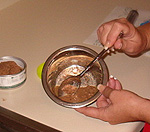
2. Fill syringe by suctioning to the feeding amount. For Skip it is currently 20 cc. Your vet will tell you the feeding amount for your kitty. Typically at first you might feed anywhere from 20-30cc every 2-3 hours.
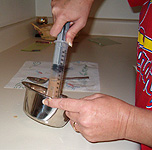
3. Fill another syringe with your water flush. For Skip it is 5cc. After each feeding you will flush the tube by placing plain water through it. This ensures there is no food stuck in the tube.
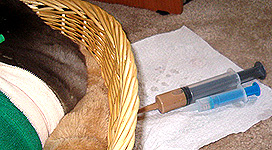
4. Clamp the tube. Some tubes come with clamps. Skip’s did not so we are using a potato chip clip.
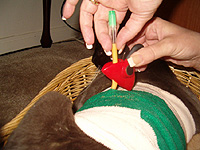
5. Take the plug out of the feeding tube.

6. Take your feeding syringe and place it in the tube by inserting the tip of the syringe into the tip of the tube. Don’t worry if it takes a couple tries. Especially at first.


7. SLOWLY syringe the food into the tube. If you syringe to quickly then your kitty may get sick. I usually syringe 1-2cc every 6-7 seconds.
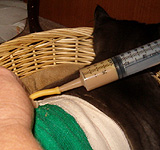
8. The whole time I am feeding Skip I tell him what a good boy he is. Last feeding he actually started purring. Speak to your pet calmly (no matter how nervous you are). They will eventually relate the feeding to praise and relaxation.
9. After the syringe is empty, I use my finger to clamp the tube so I can take the feeding syringe out of the tube.
10. Insert your water flush syringe. This is done by the exact method of the feeding syringe.

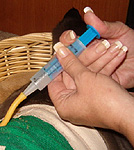
11. Recap the tube.
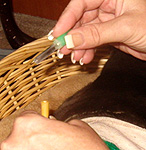
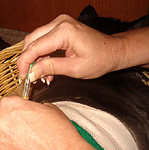
12. Rinse out the syringes for the next feeding.
13. YOU’RE DONE!!!
FYI: You can administer medications through the tube as well. Dilute the pills in either water or food. ALSO, make sure you clamp the tube BEFORE taking the plug out. If you don’t then stomach contents can come up through the tube.
That is pretty much it. The process isn’t difficult at all but being nervous at first is normal. Skippy does very well at his feedings. Skip isn’t stressed at all. He gets fed in whatever position he is in at the time of feeding. This is MUCH easier than trying to spoon feed or syringe feed – for me anyway because Skippy was very upset and stressed until we got the PEG tube.
Kitty Potpourri
Beat the Heat!
by Dan Malenski and Brigetta Walden
Thus far, summer has been relatively kind to us, but some recent heat waves suggest that we publish some methods for helping Kitty stay comfortable and safe in weather that can be dangerously hot. Thanks to the girls for pointing this out last week when we had some weather that climbed up into the nineties. Unless your cat is like the one pictured beneath this paragraph, that has her own in ground pool at her disposal, it may behoove you to read on for some reminders to keep Kitty safe and comfortable in the dog days of summer!
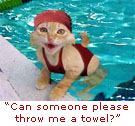
Most of us probably are already well trained (by our feline companions, of course) to keep them cool and comfortable, but those who aren’t, should carefully view the following list of tips.
- Insure that a comfortable temperature exists and ventilation is adequate.
Insure that adequate ventilation is present where the cat(s) will stay, and that their living quarters will not become dangerously hot even if the air conditioning fails. If the room feels warm to you, then it certainly is too hot for your cat considering his built-in fur coat! Create a breeze if none exists by using a fan and make sure it is out of Kitty’s reach!
Cats have hardly any sweat glands at all and typically lick themselves in hot weather, which helps to keep them cool. The moisture they spread over their bodies evaporates; thus, carrying away heat.
-
-
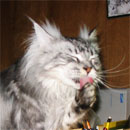
Cats normally do not cool themselves like dogs, by panting. If you do notice your cat, or any other, to be panting, it is a sign of distress and it should be taken to a veterinarian immediately.
- Conduct a tail count prior to leaving the house.
Even if you leave Kitty with the run of the house, insure that he has not been inadvertently locked in a closet prior to departing. In this house, prior to leaving the house, a “tail count” is conducted, and if the number of tails counted does not equal the number of cats living here, the search is on. Closets may become dangerously hot, especially in the summertime.
-
- Provide sufficient cool water.
To prevent dehydration, insure that your cat always has fresh, cool water, as they will use more in hot weather. It is best to provide two bowls at all times in the event that one becomes tipped over. For multiple cat households, additional water bowls should be strategically placed around their living quarters.
For outdoor cats, a bowl placed under a slowly dripping faucet is a good idea. Many indoor cats will appreciate one of the bowls being placed in the freezer, until the water is frozen. This will supply Kitty with cool water for a couple of hours or more, depending on the size of the bowl and the temperature. If you choose to do this, be sure to place an absorbent mat beneath the bowl, to protect a wooden floor or carpet from any moisture shed by the sweating of the bowl.
For those who will stop at nothing to pamper their kitties, a decorative fountain will provide cool water twenty-four hours a day and ongoing entertainment.
-
-

- Don’t skip the grooming sessions.
Comb your cat regularly to remove built up fur. Even a shorthaired cat may accumulate excess fur, which should be removed, particularly in areas where they find it hard to groom.
-
- Give extra attention to cats in outdoor enclosures.
If your cat spends time in an outdoor enclosure, in addition to the precautions mentioned above, do insure that there is shade at all times within the enclosure. If Kitty is one who likes to spend a lot of time in the sun, consider using sunscreen on exposed pink skin, usually the tips of the nose and ears. Check with your veterinarian to choose a safe sunscreen, as some, particularly those that contain zinc, can be dangerous when licked off.
-
Our girls find many ways of beating the heat. Here Melissa is showing off her cooling position underneath a ceiling fan. The breeze creates a cooling effect that she enjoys, but Mom will have to talk with her and suggest a more ladylike position!
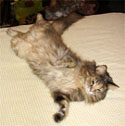
Best Cat Food
Ocean Breeze
by Garry White
Each week we are having our own cat food reviews to determine what we, or should I say, our kitties think is the best cat food.

Brand Name: Merrick Pet Foods
Product: ‘Ocean Breeze’
Type: Canned
Our Rating: ![]()
Kitty Rating: ![]()
Kitty Comments:“WOW. A brand new food that we say is the best cat food!”
Our Comments:
“Yeah, maybe it’ll make you a brand new cat, Wilbur. Although I doubt anything could do that.”
Well, it’s true; here we are again with a brand spanking new food from Merrick.so new that I don’t even have a picture of the can! The gang here loves it immensely, and the ingredients tell why: Sardines, chicken, Whitefish, Lobster (Lobster?), and of course Merrick’s usual medley of fresh veggies. They added some dried egg to this one, and I’m all for that; it’s great for their fur and skin. Also I noted a little Olive Oil in this one.we just keep getting better and better, don’t we?
If this isn’t already on the shelves in stores in your area, I heartily recommend you give it a try when it does become available. Great food, great ingredients and nutrient balance.
Website: www.merrickpetcare.com
Phone: 1-800-664-7387

Caring for Cats
Managing Guilt – Part 3
by Garry White
I’ll be perfectly honest: I had doubts about doing these articles on guilt. Would I be opening a Pandora’s Box of bad memories and pain; memories that might be best left alone to heal themselves? Or would I have enough wisdom to perhaps help soothe a wound that would never heal by itself? Well, we’re getting some very good feedback from the introduction alone, so it would appear that the issue is worthy of deeper discussion. Needless to say, the feedback tore my heart to shreds, but then I didn’t expect it to be pleasant reading.
Last week, we tried to identify the meaning of guilt, and I think we got pretty close: It’s a personal emotion that comes from within; it cannot be measured, weighed, or judged; it’s a negative emotion based on self-critique; guilt is almost always damaging.
Okay, let’s move ahead slowly from that point, and I guess the most natural progression is to assess the power of guilt. I say it’s damaging, and I’m not giving it nearly enough credit in that arena; guilt can be (and often is) emotionally crippling! No one can tell us how severely guilt will affect us, or how long it will last. It’s unique to the beings involved and the situation at hand, and only we as individuals have the ability to change the course. Before we get too deep with this train of thought, I want us to recognize the close relationship between guilt and anger, and I want us to separate the two. As I say, guilt does come from within, but an outside event is often the catalyst for it, and this is where it gets tricky. Let’s say we allow (or even promote) something to happen and it turns into a disaster.left Kitty with a neighbor while we were on vacation, and came home to a dead cat. Of course we’re angry with the thoughtless neighbor, but we’ll get over that with adequate screaming and blaming. That leaves myself.how do I feel about myself? Am I angry with myself for being so stupid as to leave my cat with that person, or am I guilty of something? Two completely different emotions: one of which will pass, and the other will probably linger for a very long time and eat away at my soul. There’s no end to the questions that could be asked, or the answers given, but it’s important that we know the difference between the two. Understandably, the scenario above can generate either (or both) emotions, and only we can control which way it goes, and to what degree. Problem is, some of us are inclined to assume guilt by reason of responsibility, and no amount of talk or outside influence can change that. Given all that I’ve said, it would seem that we’re pretty much doomed to just suffer our guilt, but I’m hoping we’ll be able to challenge that; to perhaps find some way to reason things out. Oh, there is no magical way to abolish guilt; most of us feel guilt for a reason, and it’ll always be with us to some level. But maybe we can untangle some of the logic that makes it so overwhelming and so all-consuming, and next week we’ll start to get personal about it.
Disclaimer: Kathy Fatheree is not at all a medical expert. Contents of this web site are a collection of Kathy’s assist feeding experiences as well as the experiences of other cat owners who have assist fed their cats. While every effort has been made to ensure the accuracy of the information, Kathy Fatheree or anyone associated with this web site cannot be held responsible for anything that may happen as a result of using the information on this site.
